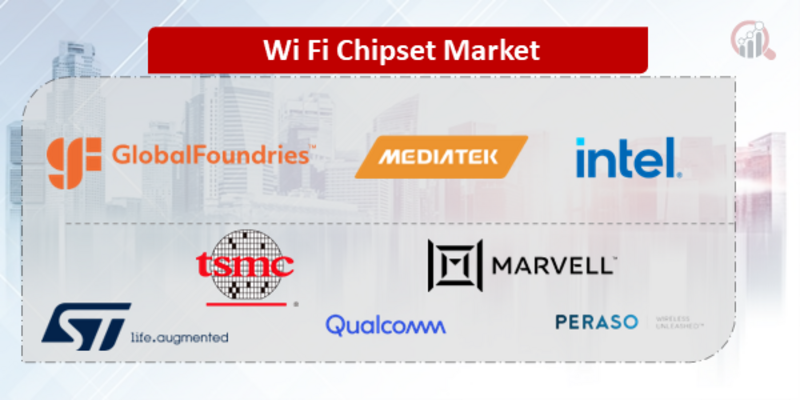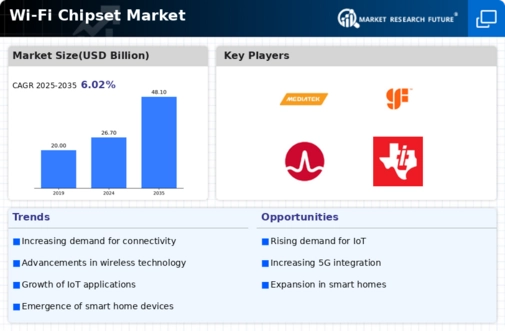Top Industry Leaders in the Wi Fi Chipset Market

*Disclaimer: List of key companies in no particular order
Competitive Landscape of the Wi-Fi Chipset Market
The Wi-Fi chipset market, estimated to reach a value of USD 26.8 billion by 2028, pulsates with a dynamic interplay of established giants and emerging challengers. This interconnected ecosystem, fueled by the relentless march of technology and the ever-growing demand for seamless connectivity, presents a fascinating picture for businesses and investors alike.
Some of the Wi-Fi Chipset companies listed below:
- Qualcomm Technologies Inc
- Mediatek Inc
- Intel Corporation
- STMicroelectronics NV
- Cypress Semiconductor Corporation
- Taiwan Semiconductor Manufacturing Co. Ltd
- Global Foundries
- Broadcom Inc
- Marvell Technology Group Ltd
- Quantenna Communications Inc
Strategies Adopted By key Players:
These established players are not resting on their laurels. They are actively investing in research and development, focusing on next-generation technologies like Wi-Fi 7, which promises even higher speeds and lower latency. Additionally, acquisitions and strategic partnerships play a crucial role in strengthening their hold. The recent acquisition of Marvell's Wi-Fi and Bluetooth assets by Qualcomm is a testament to this trend.
Factors for Market Share Analysis:
Understanding market share dynamics is crucial for navigating this competitive landscape. Key factors influencing share include:
- Product Portfolio and Technology Leadership: Offering a diverse range of chipsets catering to different price points and applications is key. Companies leading the charge in Wi-Fi 6E and Wi-Fi 7 development will gain an edge.
- Target Markets and Partnerships: Focusing on specific segments like smartphones, IoT devices, or enterprise solutions offers growth opportunities. Strong partnerships with device manufacturers and service providers further solidify market share.
- Cost and Performance Optimization: Balancing affordability with cutting-edge technology is essential. Companies adept at producing high-performance chipsets at competitive prices will attract more customers.
- Regional Focus: The market varies across regions. Understanding specific regional demands and regulations is crucial for success.
New and Emerging Companies:
The Wi-Fi chipset market is not a closed club. New players are constantly emerging, bringing fresh perspectives and innovative solutions. Companies like Realtek and STMicroelectronics are pushing boundaries in the low-power and high-integration segments. Additionally, startups like Cerebras Systems and Quantenna are focusing on niche applications like mesh networking and millimeter-wave technology. These newcomers, with their agility and focus on specific areas, pose potential challenges to established players.
Latest Company Updates:
China's Xiaomi introduced the Xiaomi Mi13 Pro, the first smartphone with Wi-Fi 7 support, in 2023. The phone is the first to use Qualcomm's brand-new Snapdragon 8 Gen 2 platform, and it has so far only been made available in China. Qualcomm's Fast Connect 7800 Wi-Fi 7 connection platform is built into Snapdragon 8 Gen 2.
The Helio G36 chipset, which MediaTek, a fabless chip manufacturer, will introduce in 2023 and support for 4G, WiFi 5, and Bluetooth 5.0, is intended for entry-level gaming smartphones in India. The octa-core MediaTek Helio G36 chipset supports up to 8GB of LPDDR4x RAM and has a maximum CPU speed of 2.2GHz when combined with the IMG PowerVR GE8320 GPU. In addition, the new MediaTek G-series chipset enables cameras with up to 50 megapixels and a hardware depth engine for bokeh, while smartphone manufacturers may utilise the Helio G36 to drive displays with up to HD+ 90 Hz.








